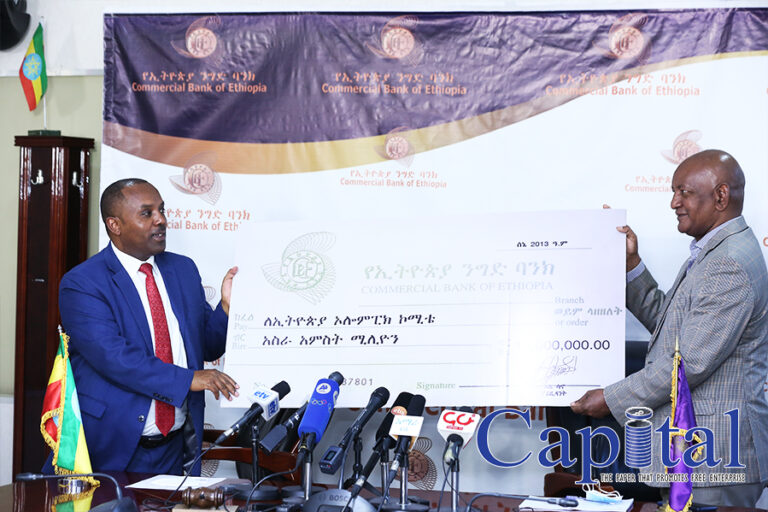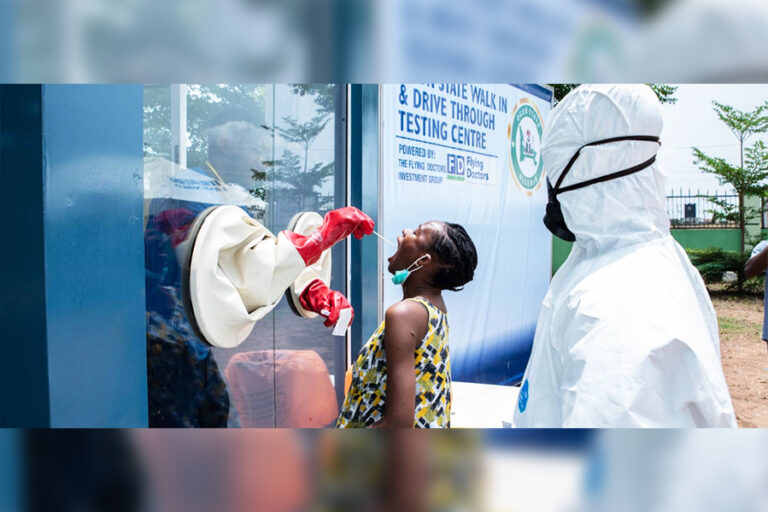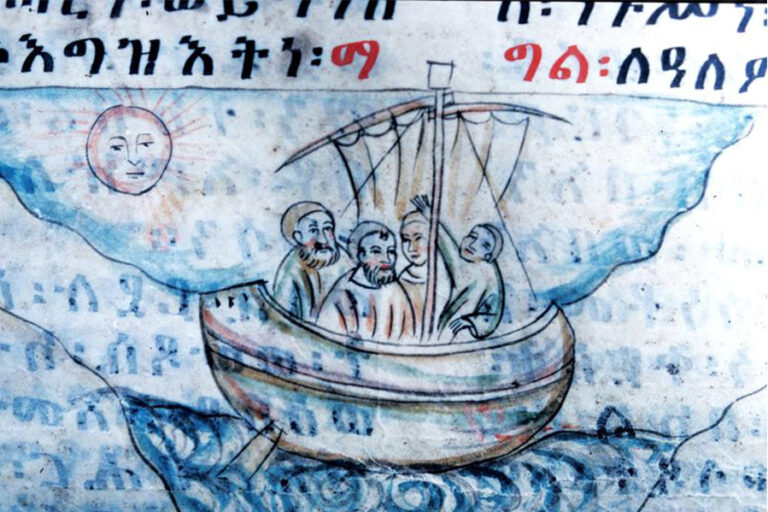CBE has donated 15 million Birr to The Ethiopian Olympic Committee to support the preparation of the Ethiopian Olympic Team for the upcoming Tokyo 2020 Olympics.
Abe Sano President of CBE presented the cheque to Olympic Committee President Ashebir Woldegiorgis.
The money will help to cover the cost of the team while travelling to Tokyo.
Originally scheduled to take place from 24 July to 9 August 2020, the event was postponed in March 2020 as a result of the COVID-19 pandemic, and will not allow international spectators. Despite being rescheduled for 2021, to be held from 23 July to 8 August 2021, the event retains the Tokyo 2020 name for marketing and branding purposes. This is the first time that the Olympic Games have been postponed and rescheduled, rather than cancelled. The Summer Paralympics will be held between 24 August and 5 September 2021 after the Olympics.
The Tokyo 2020 Games will see the introduction of new competitions including 3×3 basketball, freestyle BMX, and madison cycling, as well as further mixed events. Under new International Olympic Committee policies, which allow the host organizing committee to add new sports to the Olympic program to augment the permanent core events, these Games will see karate, sport climbing, surfing, and skateboarding make their Olympic debuts, as well as the return of baseball and softball for the first time since 2008.
CBE donates 15 million Birr to The Ethiopian Olympic Committee
Africa faces steepest COVID-19 surge yet
The COVID-19 upsurge comes as the vaccine supply crunch persists.
Africa is facing a fast-surging third wave of COVID-19 pandemic, with cases spreading more rapidly and projected to soon overtake the peak of the second wave the continent witnessed at the start of 2021.
COVID-19 cases have risen for five consecutive weeks since the onset of the third wave on 3 May 2021. As of 20 June-day 48 into the new wave-Africa had recorded around 474 000 new cases-a 21% increase compared with the first 48 days of the second wave. At the current rate of infections, the ongoing surge is set to surpass the previous one by early July.
The pandemic is resurging in 12 African countries. A combination of factors including weak observance of public health measures, increased social interaction and movement as well as the spread of variants are powering the new surge. In the Democratic Republic of the Congo and Uganda that are experiencing COVID-19 resurgence, the Delta variant has been detected in most samples sequenced in the past month. Across Africa, the variant-first identified in India-has been reported in 14 countries.
“The third wave is picking up speed, spreading faster, hitting harder. With rapidly rising case numbers and increasing reports of serious illness, the latest surge threatens to be Africa’s worst yet,” said Dr Matshidiso Moeti, World Health Organization (WHO) Regional Director for Africa. “Africa can still blunt the impact of these fast-rising infections, but the window of opportunity is closing. Everyone everywhere can do their bit by taking precautions to prevent transmission.”
WHO is deploying more experts to some of the worst-affected countries, including Uganda and Zambia as well as supporting South Africa-based regional laboratories to monitor variants of concern. WHO is also boosting innovative technological support to other laboratories in the region without sequencing capacities to better monitor the evolution of the virus. In the next six months, WHO is aiming for an eight- to ten-fold increase in the samples sequenced each month in Southern African countries.
The COVID-19 upsurge comes as the vaccine supply crunch persists. Eighteen African countries have used over 80% of their COVAX vaccine supplies, with eight having exhausted their stocks. Twenty-nine countries have administered over 50% of their supplies. Despite the progress, just over 1% of Africa’s population has been fully vaccinated. Globally, around 2.7 billion doses administered, of which just under 1.5% have been administered in the continent.
As many high-income countries vaccinate a significant proportion of their populations, proof of vaccination is leading to fewer movement restrictions. Globally,16 countries are waiving quarantine for those with a vaccination certificate. Measures to prevent COVID-19 transmission are crucial, but with many African countries having limited access to vaccines, it is important that vaccines be only one of the conditions countries use to open borders and increase freedom of movement.
“With high vaccination rates it’s shaping up into a summer of freedom, family and fun for millions of people in richer countries. This is understandable and we all long for the same joys,” said Dr Moeti. “Vaccine shortages are already prolonging the pain of COVID-19 in Africa. Let’s not add injury to injustice. Africans must not face more restrictions because they are unable to access vaccines that are only available elsewhere. I urge all regional and national regulatory agencies to recognize all the vaccines Emergency Use listed by WHO.”
In the European Union, a COVID-19 passport system for vaccination, testing and recovery will take effect from 1 July. However, only four of the eight vaccines listed by WHO for emergency use are recognized by the European Medicines Agency for the passport system.
WHO and the European Medicines Agency use the same standards in assessing vaccines. Manufacturers may choose not to apply to the European Medicines Agency if they do not intend to market their products in countries in the European Union or European Economic Area. But the safety and efficacy of all WHO emergency use listed vaccines has been proven globally in preventing severe COVID-19 illness and death.
In Africa, a WHO survey of 45 countries show that their borders are open for air travel and only Mauritius will require proof of vaccination for international travellers from 15 July 2021. Most countries do not give quarantine exemptions for travellers who are fully vaccinated against COVID-19 and require a negative COVID-19 test.
(Africa Renewal)
Yomif Kejelcha wins Oslo Diamond League
Ethiopian Athlete Yomif Kejelcha has scored victory in Oslo Diamond League, Norway. Yomif held impressive personal best in running the 3000 meters race with 26:26:25.
On the other hand, in women’s 5,000 meters, Fantu Worke finished the race second following the Kenyan athlete Helen Obiri.
Athlete Yomif Kejelcha won a silver medal in the men’s 10,000 metres at the 2019 World Athletics Championships in Doha, Qatar. He is the current world indoor record holder in the mile.
A New History Changes the Balance of Power Between Ethiopia and Medieval Europe
For centuries, a Eurocentric worldview disregarded the knowledge and strength of the African empire
By David M. Perry , Matthew Gabriele
In early 2020, just as the scope and scale of the coronavirus pandemic was revealing itself, historian Verena Krebs went to spend a few months at her parents’ house in the German countryside. There, “next to fields of rapeseed and barley and dense old woods,” in her words, the Ruhr-University Bochum professor would wait out Germany’s lockdown. She wasn’t terribly worried about not having things to do though, since she had her book on the history of late medieval Ethiopia to finish up.
The good news was that she had already completed the full manuscript and had secured a contract with a major academic publisher. The bad news was more existential: She didn’t like the book she had written. Krebs knew her sources ran against the dominant narrative that placed Europe as aiding a needy Ethiopia, the African kingdom desperately in search of military technology from its more sophisticated counterparts to the north. But her writing didn’t fully match her research; it still followed the prevailing scholarship. Krebs worried that her interpretation of the original medieval sources was, in her own words, too “out there’” So, she hedged, and she struggled, and she doubted, and wrote the book she thought she was supposed to write.
And then, she told us, she did something radical. Instead of tweaking what was already written, she decided to do what good historians do and follow the sources. “I basically deleted the manuscript that I had submitted. And I just wrote the whole thing anew. I started writing in April, and I finished the whole thing by, I think, August.”
What emerged, published earlier this year as Medieval Ethiopian Kingship, Craft, and Diplomacy with Latin Europe, is a story that flips the script. Traditionally, the story centered Europe and placed Ethiopia as periphery, a technologically backwards Christian kingdom that, in the later Middle Ages, looked to Europe for help. But by following the sources, Krebs showcases the agency and power of Ethiopia and Ethiopians at the time and renders Europe as it was seen from East Africa, as a kind of homogenous (if interesting) mass of foreigners.
It’s not that modern historians of the medieval Mediterranean, Europe and Africa have been ignorant about contacts between Ethiopia and Europe; the issue was that they had the power dynamic reversed. The traditional narrative stressed Ethiopia as weak and in trouble in the face of aggression from external forces, especially the Mamluks in Egypt, so Ethiopia sought military assistance from their fellow Christians to the north—the expanding kingdoms of Aragon (in modern Spain), and France. But the real story, buried in plain sight in medieval diplomatic texts, simply had not yet been put together by modern scholars. Krebs’ research not only transforms our understanding of the specific relationship between Ethiopia and other kingdoms, but joins a welcome chorus of medieval African scholarship pushing scholars of medieval Europe to broaden their scope and imagine a much more richly connected medieval world.
The Solomonic kings of Ethiopia, in Krebs’ retelling, forged trans-regional connections. They “discovered” the kingdoms of late medieval Europe, not the other way around. It was the Africans who, in the early-15th century, sent ambassadors out into strange and distant lands. They sought curiosities and sacred relics from foreign leaders that could serve as symbols of prestige and greatness. Their emissaries descended onto a territory that they saw as more or less a uniform “other,” even if locals knew it to be a diverse land of many peoples. At the beginning of the so-called Age of Exploration, a narrative that paints European rulers as heroes for sending out their ships to foreign lands, Krebs has found evidence that the kings of Ethiopia were sponsoring their own missions of diplomacy, faith and commerce.
But the history of medieval Ethiopia extends much farther back than the 15th and 16th centuries and has been intertwined with the better-known history of the Mediterranean since the very beginning of Christianity’s expansion. “[The kingdom of Ethiopia] is one of the most ancient Christian realms in the world,” she says. Aksum, a predecessor kingdom to what we now know as Ethiopia, “[converts] to Christianity in the very early fourth century,” much earlier than the mass of the Roman empire, which only converted to Christianity by the sixth or seventh century. The Solomonic dynasty specifically arose around 1270 A.D. in the highlands of the Horn of Africa and by the 15th century had firmly consolidated power. Their name arose out of their claim of direct descent from King Solomon of ancient Israel, via his purported relationship with the Queen of Sheba. Although they faced several external threats, they consistently beat those threats back and expanded their kingdom across the period, establishing uneasy (though generally peaceful) relations with Mamluk Egypt and inspiring wonder across Christian Europe.
It’s at this time, Krebs says, that the Ethopian rulers looked back to Aksum with nostalgia, “It’s its own little Renaissance, if you will, where Ethiopian Christian kings are actively going back to Late Antiquity and even reviving Late Antique models in art and literature, to make it their own.” So, in addition to investing in a shared culture of art and literature, they followed a well-worn model used by rulers across the Mediterranean, and throughout Europe, Asia, and Africa, by turning to religion. They build churches.They reach out to the Coptic Christians living in Egypt under the Islamic Mamluks to present themselves as a kind of (theoretical) protector. The Solomonic kings of Ethiopia consolidated a huge “multilingual, multi-ethnic, multi-faith kingdom” under their rule, really a kind of empire.
And that empire needed to be adorned. Europe, Krebs says, was for the Ethiopians a mysterious and perhaps even slightly barbaric land with an interesting history and, importantly, sacred stuff that Ethiopian kings could obtain. They knew about the Pope, she says, “But other than that, it’s Frankland. [Medieval Ethiopians] had much more precise terms for Greek Christianity, Syriac Christianity, Armenian Christianity, the Copts, of course. All of the Orthodox and Oriental Orthodox churches. But everything Latin Christian [to the Ethiopians] is Frankland.”
Krebs is attuned to the challenges of being an outsider, a European rewriting Ethiopian history. Felege-Selam Yirga, a medieval historian at the University of Tennessee-Knoxville, told us over email that Krebs has recognized that “Ethiopian diplomatic contacts with and perception of Europe [were] far more complex [than has been traditionally understood].” Yirga says that much of the study of late medieval Ethiopia and Europe “was informed by the colonial and [20th-century] fascist setting in which many … scholars of East Africa worked. While Ethiopian studies is awash in new discoveries and excellent philological and historical work, certain older works and authors remain popular and influential.” Indeed, these were points that Krebs herself emphasized—that following the footnotes back in time often led to dead-ends in scholarship produced in 1930s and 1940s Italy, under the thrall of fascism and entertaining new colonial ambitions that culminated in the country’s successful invasion of Ethiopia in 1935.
The book is already having an impact on life outside the academy. Solomon Gebreyes Beyene, a research fellow from Ethiopia now at the University of Hamburg, told us, “Most ordinary Ethiopians who have completed high school and even university have learned that Ethiopia pursued a closed-door policy in the Middle Ages,” or at most desperately sought military help and weapons from the north. Perhaps because of that, medieval Ethiopia isn’t a period that’s discussed much at all. Krebs’ book changes all that, he says. It opens up the period and “enables Ethiopian scholars and the general public to learn more about the glorious diplomatic history of Ethiopia’s medieval history, and it also serves as a reference for university students and professors.” He adds, “I also appreciated that, far from favoring a Eurocentric view, the book approaches history from an Ethiopian perspective. It makes another glorious contribution to the historiography of medieval Ethiopian history.”
Krebs is not content to sit back and watch what happens next. As befits a scholar who literally threw out a fully written book and wrote a better and more rigorous one over the course of a summer, she remains focused on not only changing Ethiopian history but ensuring that their story is integrated into other stories told about the medieval world. She told us that, especially in the 15th century, you have these “kings who see themselves as the center of the universe, who are sitting in these Highlands in the Horn of Africa and perceiving themselves as not just the heirs of biblical King Solomon, but as the first kings among the earth. And so I mean, that just changes how we need to read, in that case, African-European interactions.” Following the sources, it’s quite clear that the medieval world was much wider and more expansive than many have thought.
This article is part of a series on medieval history connected to the December 2021 release of the authors’ new book The Bright Ages: A New History of Medieval Europe.







